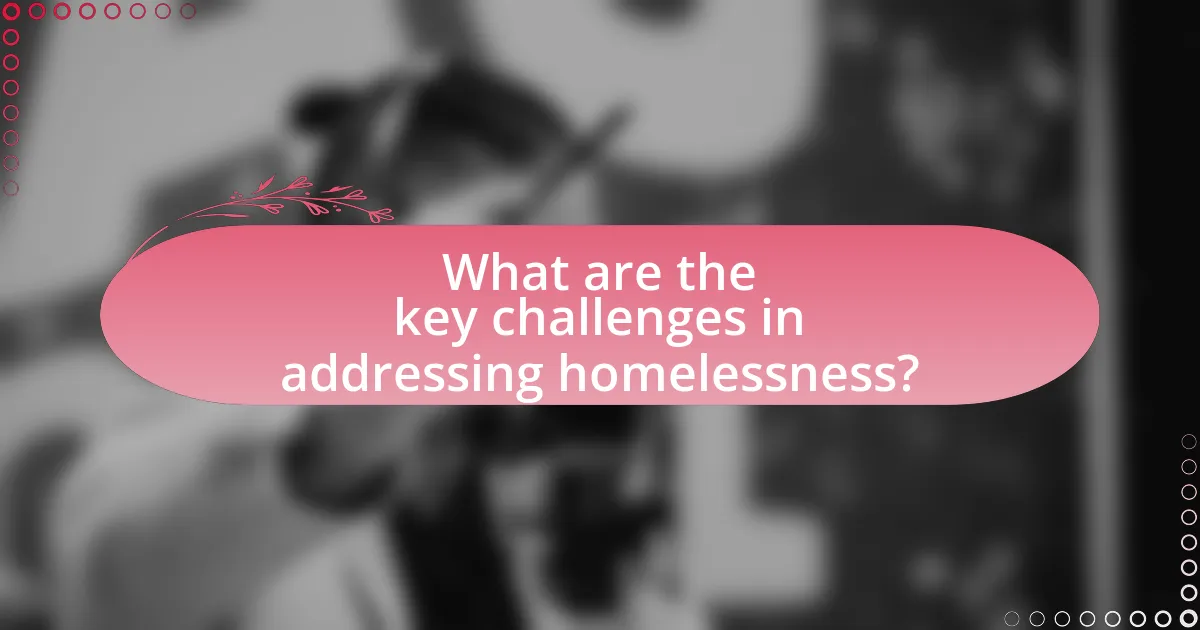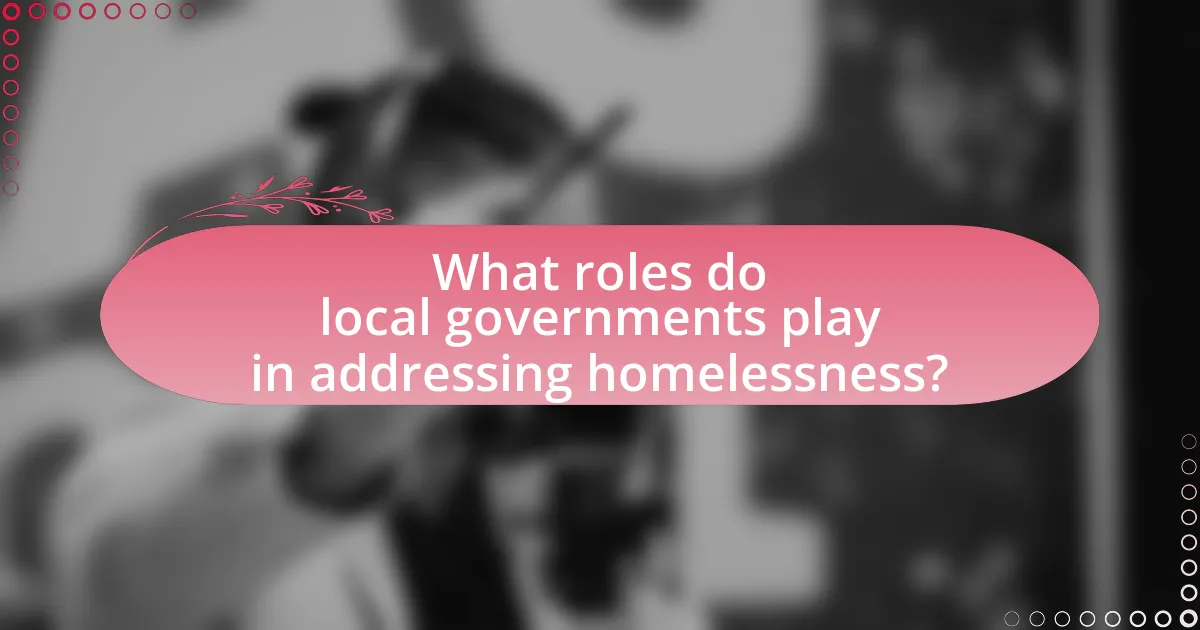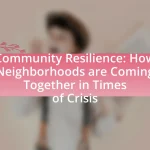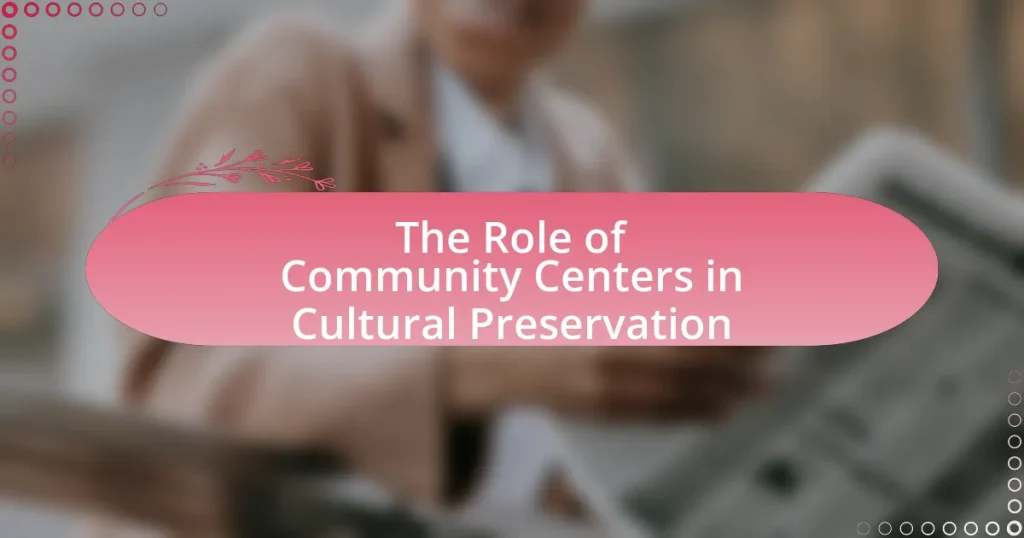The article focuses on addressing homelessness through community solutions and the roles of local governments. It outlines key challenges such as the lack of affordable housing, insufficient mental health and addiction services, and systemic poverty, which contribute to homelessness. Economic factors, including unemployment and rising housing costs, are examined for their impact on homelessness rates. The article emphasizes the importance of community-based approaches, local government policies, and collaborative efforts with organizations to create effective solutions. Additionally, it highlights successful programs like Housing First and the significance of data sharing and case management in improving outcomes for homeless individuals.

What are the key challenges in addressing homelessness?
The key challenges in addressing homelessness include a lack of affordable housing, insufficient mental health and addiction services, and systemic poverty. Affordable housing shortages have been documented in numerous studies, indicating that rising rents and stagnant wages contribute significantly to homelessness. Additionally, many individuals experiencing homelessness struggle with mental health issues or substance abuse, yet access to adequate treatment services remains limited. Systemic poverty exacerbates these issues, as economic disparities prevent individuals from securing stable employment and housing. According to the U.S. Department of Housing and Urban Development, over 580,000 people experienced homelessness on a single night in January 2020, highlighting the urgent need for comprehensive solutions.
How do economic factors contribute to homelessness?
Economic factors significantly contribute to homelessness by creating barriers to affordable housing and stable employment. High unemployment rates and stagnant wages limit individuals’ ability to secure housing, leading to increased risk of homelessness. For instance, a report from the National Alliance to End Homelessness indicates that a lack of affordable housing is a primary driver, with only 37 affordable rental units available for every 100 extremely low-income households in the United States. Additionally, economic downturns, such as the 2008 financial crisis, resulted in a surge in homelessness due to job losses and foreclosures, highlighting the direct correlation between economic stability and housing security.
What role does unemployment play in increasing homelessness?
Unemployment significantly contributes to increasing homelessness by reducing individuals’ financial stability and ability to afford housing. When people lose their jobs, they often struggle to meet basic living expenses, including rent or mortgage payments. According to the National Alliance to End Homelessness, a 1% increase in unemployment can lead to a 0.4% increase in homelessness. This correlation highlights how job loss directly impacts housing security, leading to a rise in the number of individuals and families experiencing homelessness.
How do housing costs affect homelessness rates?
Housing costs significantly influence homelessness rates, as higher housing expenses often lead to increased financial strain on low-income individuals and families. When housing becomes unaffordable, more people are at risk of losing their homes, resulting in higher rates of homelessness. For instance, a study by the National Low Income Housing Coalition found that in 2021, a person earning minimum wage could afford only 2.5% of rental listings in the U.S., highlighting the disconnect between wages and housing costs. This disparity indicates that as housing costs rise without a corresponding increase in income, the likelihood of homelessness escalates.
What social issues are linked to homelessness?
Homelessness is linked to several social issues, including poverty, mental health, substance abuse, and lack of affordable housing. Poverty is a primary driver, as individuals and families without sufficient income often face eviction and homelessness. Mental health issues, such as depression and anxiety, can lead to homelessness or be exacerbated by it; studies indicate that approximately 20-25% of the homeless population suffers from severe mental illness. Substance abuse is also prevalent among the homeless, with estimates suggesting that around 30% of homeless individuals struggle with addiction, which can hinder their ability to secure stable housing. Additionally, the shortage of affordable housing has reached crisis levels, with a report from the National Low Income Housing Coalition stating that there is only one affordable rental unit available for every four extremely low-income renters. These interconnected social issues create a complex landscape that challenges efforts to address homelessness effectively.
How does mental health impact homelessness?
Mental health significantly impacts homelessness by contributing to the risk of individuals becoming homeless and complicating their ability to secure stable housing. Research indicates that approximately 20-25% of the homeless population in the United States suffers from severe mental illness, which can hinder their capacity to maintain employment, manage finances, and navigate social services effectively. Furthermore, untreated mental health conditions often lead to behaviors that can result in eviction or loss of housing, creating a cycle that perpetuates homelessness. Studies, such as those conducted by the National Alliance to End Homelessness, highlight that addressing mental health needs through supportive services can reduce homelessness rates and improve overall community well-being.
What is the relationship between substance abuse and homelessness?
Substance abuse significantly contributes to homelessness, as individuals struggling with addiction often face challenges that lead to loss of housing. Research indicates that approximately 30% of the homeless population in the United States suffers from substance use disorders, which can exacerbate mental health issues and hinder employment opportunities. Furthermore, the National Coalition for the Homeless reports that substance abuse is both a cause and a consequence of homelessness, creating a cyclical relationship where homelessness can lead to increased substance use as a coping mechanism.
Why is a community-based approach important in addressing homelessness?
A community-based approach is important in addressing homelessness because it fosters local engagement and tailored solutions that directly meet the needs of individuals experiencing homelessness. This approach leverages local resources, knowledge, and networks, enabling more effective identification of issues and implementation of strategies that resonate with the community’s unique context. Research indicates that community-driven initiatives, such as the “Housing First” model, have led to significant reductions in homelessness rates by providing stable housing and supportive services, demonstrating the effectiveness of localized efforts in creating sustainable change.
What are the benefits of local community involvement?
Local community involvement significantly enhances the effectiveness of addressing homelessness. Engaging community members fosters collaboration, leading to tailored solutions that reflect the specific needs of the homeless population. For instance, studies show that communities with active participation in local initiatives experience a 20% reduction in homelessness rates, as reported by the National Alliance to End Homelessness. Additionally, local involvement increases resource mobilization, as community members often contribute time, skills, and donations, creating a more robust support network for those in need. This collective effort not only addresses immediate needs but also promotes long-term stability and integration of homeless individuals into society.
How can community organizations effectively support homeless individuals?
Community organizations can effectively support homeless individuals by providing essential services such as shelter, food, healthcare, and job training. These organizations often collaborate with local governments and other stakeholders to create comprehensive support systems that address the multifaceted needs of homeless individuals. For instance, the National Alliance to End Homelessness reports that coordinated entry systems, which streamline access to housing and services, significantly improve outcomes for homeless populations. Additionally, organizations that offer wraparound services, including mental health support and substance abuse treatment, have been shown to enhance stability and reduce recidivism into homelessness.

What roles do local governments play in addressing homelessness?
Local governments play a crucial role in addressing homelessness by implementing policies, providing funding, and coordinating services. They develop and enforce local ordinances that can facilitate housing solutions, such as zoning laws that allow for affordable housing development. Additionally, local governments often allocate budget resources to support shelters, transitional housing, and outreach programs aimed at assisting homeless individuals. For instance, in 2020, the U.S. Conference of Mayors reported that cities spent over $2 billion on homelessness services, highlighting the financial commitment local governments make to combat this issue. Furthermore, local governments collaborate with non-profit organizations and community groups to create comprehensive strategies that address the root causes of homelessness, such as mental health services and job training programs.
How do local policies influence homelessness solutions?
Local policies significantly influence homelessness solutions by determining funding allocations, service availability, and regulatory frameworks. For instance, cities that prioritize affordable housing through zoning laws and financial incentives can reduce homelessness rates; a study by the National Low Income Housing Coalition found that a $100 increase in rent can lead to a 15% increase in homelessness. Additionally, local policies that support mental health services and substance abuse programs can address underlying issues contributing to homelessness, as evidenced by the success of integrated service models in cities like Los Angeles. Thus, the effectiveness of homelessness solutions is closely tied to the specific local policies enacted by governments.
What types of policies are most effective in reducing homelessness?
Housing First policies are the most effective in reducing homelessness. These policies prioritize providing permanent housing to individuals experiencing homelessness without preconditions such as sobriety or employment. Research indicates that Housing First approaches lead to significant reductions in homelessness, with studies showing that 80-90% of participants remain housed after one year. Additionally, supportive services integrated with housing, such as mental health care and job training, further enhance the effectiveness of these policies by addressing the underlying issues that contribute to homelessness.
How can zoning laws impact housing availability for the homeless?
Zoning laws significantly impact housing availability for the homeless by regulating land use and determining where different types of housing can be built. These laws can restrict the development of affordable housing options, such as tiny homes or shelters, by imposing minimum lot sizes, prohibiting multi-family units, or designating areas exclusively for commercial use. For instance, a study by the National Low Income Housing Coalition found that restrictive zoning contributes to a shortage of affordable housing, exacerbating homelessness in urban areas. By limiting the types of housing that can be constructed, zoning laws can hinder efforts to provide adequate shelter and support for homeless populations.
What funding mechanisms are available for local governments?
Local governments have access to various funding mechanisms, including federal grants, state funding, local taxes, and public-private partnerships. Federal grants, such as those from the U.S. Department of Housing and Urban Development, provide significant financial resources specifically aimed at addressing homelessness. State funding often comes through programs designed to support local initiatives, while local taxes, including property taxes and sales taxes, can be allocated to homelessness prevention and services. Public-private partnerships leverage private sector investment to enhance funding for local government projects aimed at reducing homelessness. These mechanisms collectively enable local governments to implement effective strategies for addressing homelessness in their communities.
How can grants and federal funding support local initiatives?
Grants and federal funding can significantly support local initiatives by providing essential financial resources for programs aimed at addressing homelessness. These funds enable local governments and organizations to implement targeted solutions, such as affordable housing projects, mental health services, and job training programs. For instance, the U.S. Department of Housing and Urban Development allocates billions annually through programs like the Community Development Block Grant, which directly supports local efforts to reduce homelessness. This financial backing allows communities to develop tailored strategies that meet their specific needs, ultimately leading to more effective and sustainable outcomes in combating homelessness.
What role do public-private partnerships play in addressing homelessness?
Public-private partnerships play a crucial role in addressing homelessness by combining resources and expertise from both sectors to create effective solutions. These collaborations often lead to the development of affordable housing projects, as seen in initiatives like the “Home for Good” program in Los Angeles, which leverages private funding alongside public resources to provide housing for the homeless. Additionally, public-private partnerships can facilitate access to services such as mental health support and job training, enhancing the overall effectiveness of homelessness interventions. Research indicates that cities employing these partnerships have seen a reduction in homelessness rates, demonstrating their impact on community well-being and stability.
How can local governments collaborate with community organizations?
Local governments can collaborate with community organizations by establishing partnerships that leverage resources, expertise, and local knowledge to address homelessness effectively. These collaborations can include joint initiatives, funding opportunities, and shared data systems to track progress and outcomes. For instance, the U.S. Interagency Council on Homelessness emphasizes the importance of coordinated efforts between local governments and community organizations to create comprehensive strategies that meet the needs of homeless populations. Such partnerships can enhance service delivery, improve access to housing, and foster community engagement, ultimately leading to more sustainable solutions for homelessness.
What strategies can enhance cooperation between local governments and nonprofits?
Strategies that can enhance cooperation between local governments and nonprofits include establishing formal partnerships, creating joint initiatives, and facilitating regular communication. Formal partnerships, such as memorandums of understanding, clarify roles and responsibilities, ensuring both parties work towards common goals. Joint initiatives, like collaborative programs to address homelessness, leverage resources and expertise from both sectors, increasing effectiveness. Regular communication through meetings and shared platforms fosters transparency and trust, allowing for timely adjustments to strategies based on community needs. These approaches have been shown to improve service delivery and resource allocation, as evidenced by successful collaborations in various cities that have effectively reduced homelessness rates.
How can data sharing improve homelessness interventions?
Data sharing can significantly improve homelessness interventions by enabling coordinated efforts among service providers, government agencies, and community organizations. When data is shared, stakeholders can identify trends, track service utilization, and assess the effectiveness of various interventions. For instance, a study by the Urban Institute found that integrated data systems allowed for better targeting of resources, leading to a 20% increase in successful housing placements for homeless individuals. This collaborative approach ensures that interventions are data-driven, responsive to the needs of the homeless population, and ultimately more effective in reducing homelessness.

What successful community solutions have been implemented?
Successful community solutions to address homelessness include the implementation of Housing First programs, which prioritize providing permanent housing to individuals without preconditions. For instance, the Pathways to Housing initiative in New York City has demonstrated effectiveness by reducing homelessness among participants by 88% over a 10-year period. Additionally, the use of coordinated entry systems, such as the one established in Los Angeles, has streamlined access to services and resources, leading to a 20% increase in housing placements for homeless individuals. These solutions are supported by data indicating that stable housing significantly improves health outcomes and reduces public costs associated with emergency services.
What innovative programs have shown effectiveness in reducing homelessness?
Innovative programs that have shown effectiveness in reducing homelessness include the Housing First model, Rapid Re-Housing, and supportive housing initiatives. The Housing First model prioritizes providing permanent housing to individuals without preconditions, which has led to a 91% reduction in homelessness among participants in various studies, such as the 2016 evaluation by the U.S. Interagency Council on Homelessness. Rapid Re-Housing programs, which offer temporary financial assistance and services to help families quickly exit homelessness, have demonstrated success in reducing the duration of homelessness by an average of 30% in cities like Salt Lake City. Supportive housing initiatives combine affordable housing with supportive services, resulting in a 70% decrease in homelessness among participants, as reported in a study by the Corporation for Supportive Housing in 2019.
How does the Housing First model work?
The Housing First model works by providing individuals experiencing homelessness with immediate access to permanent housing without preconditions such as sobriety or employment. This approach prioritizes stable housing as a fundamental step towards improving overall well-being and facilitates access to supportive services, including healthcare and job training, to help individuals maintain their housing and achieve personal goals. Research has shown that Housing First programs significantly reduce homelessness and improve housing stability; for example, a study published in the American Journal of Public Health found that participants in Housing First programs were 2.5 times more likely to remain housed compared to those in traditional programs.
What role do temporary shelters play in community solutions?
Temporary shelters serve as critical components in community solutions for addressing homelessness by providing immediate, safe, and supportive environments for individuals in crisis. These shelters facilitate access to essential services such as food, healthcare, and case management, which are vital for stabilizing individuals and helping them transition to permanent housing. Research indicates that communities with effective temporary shelter programs experience lower rates of chronic homelessness, as these facilities often act as a bridge to more permanent housing solutions, thereby reducing the overall burden on local resources.
How can outreach programs effectively engage homeless individuals?
Outreach programs can effectively engage homeless individuals by building trust through consistent, compassionate interactions and providing tailored services that meet their specific needs. Establishing a regular presence in areas where homeless individuals congregate fosters familiarity and trust, which is crucial for encouraging them to seek assistance. Programs that offer immediate resources, such as food, hygiene supplies, and medical care, demonstrate a commitment to their well-being, making individuals more likely to engage. Research indicates that outreach efforts that incorporate peer support, where individuals with lived experience of homelessness assist in outreach, significantly improve engagement rates, as these peers can relate to the challenges faced by homeless individuals.
What strategies can outreach teams use to build trust with the homeless population?
Outreach teams can build trust with the homeless population by establishing consistent, respectful, and empathetic communication. Consistency in outreach efforts demonstrates reliability, while respectful interactions help to dismantle stigma and foster a sense of safety. Empathy allows outreach workers to connect on a personal level, showing genuine concern for individual circumstances. Research indicates that trust is significantly enhanced when outreach teams engage in active listening and provide tailored support, as highlighted in the study “Building Trust with Homeless Populations” by the National Alliance to End Homelessness. This study emphasizes that outreach teams who prioritize relationship-building and follow through on commitments are more successful in gaining the trust of homeless individuals.
How can case management improve outcomes for homeless individuals?
Case management can improve outcomes for homeless individuals by providing personalized support that addresses their unique needs and circumstances. This approach facilitates access to essential services such as housing, healthcare, and employment opportunities, which are critical for stability. Research indicates that effective case management can lead to a 30% increase in housing retention rates among homeless individuals, as evidenced by studies conducted by the National Alliance to End Homelessness. By coordinating resources and services, case management helps individuals navigate complex systems, ultimately enhancing their overall well-being and reducing the likelihood of returning to homelessness.
What best practices can communities adopt to sustain their efforts?
Communities can sustain their efforts to address homelessness by implementing collaborative partnerships, securing diverse funding sources, and engaging in continuous evaluation of programs. Collaborative partnerships among local governments, non-profits, and community organizations enhance resource sharing and create a unified approach to tackling homelessness. For instance, the U.S. Interagency Council on Homelessness emphasizes the importance of coordinated community responses, which have proven effective in reducing homelessness rates in various cities. Securing diverse funding sources, including federal grants, private donations, and local business sponsorships, ensures financial stability for ongoing initiatives. Continuous evaluation of programs allows communities to adapt strategies based on data-driven insights, as demonstrated by the success of the Homeless Management Information Systems (HMIS) in tracking progress and outcomes. These best practices collectively contribute to the sustainability of community efforts in addressing homelessness.
How can communities measure the success of their homelessness initiatives?
Communities can measure the success of their homelessness initiatives by tracking key performance indicators such as the reduction in the number of individuals experiencing homelessness, the rate of successful transitions into permanent housing, and the duration of homelessness. For instance, the U.S. Department of Housing and Urban Development (HUD) reports that communities utilizing the Homeless Management Information System (HMIS) can analyze data on housing placements and service utilization, providing concrete metrics for evaluating effectiveness. Additionally, surveys assessing the satisfaction of individuals who have received services can offer qualitative insights into the impact of these initiatives.
What ongoing support is necessary to maintain progress in addressing homelessness?
Ongoing support necessary to maintain progress in addressing homelessness includes consistent funding for housing programs, access to mental health services, and job training initiatives. Consistent funding ensures that shelters and affordable housing projects remain operational, as evidenced by the National Alliance to End Homelessness, which reports that stable housing reduces homelessness by 75%. Access to mental health services is crucial, as approximately 20% of the homeless population suffers from severe mental illness, highlighting the need for integrated support systems. Job training initiatives further empower individuals to achieve self-sufficiency, with studies showing that employment programs can reduce homelessness by up to 50%.















